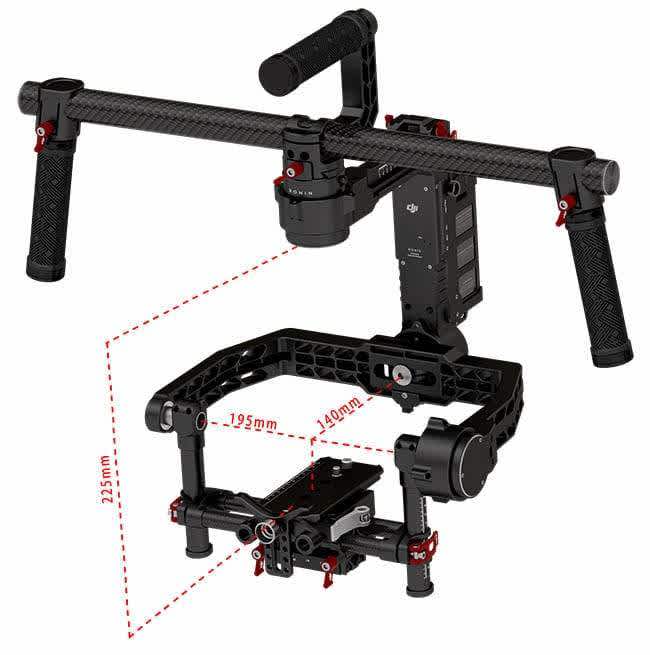
Updated on • 9 Sep 2024
Ronin or Ronin-M? Weighing Them Up
The DJI Ronin and Ronin-M are great camera stabilisation gimbals for handheld use or for mounting on jibs and cranes but which is better? ... Read More
If you've flown your camera on a DJI drone you'll know how smooth and slick the shots can be thanks to the revolutionary brushless motor gimbals. But that wonderful technology is also available back on the ground. The DJI Ronin and its smaller, lighter, brother, the Ronin-M will be an absolute revelation to the videographer who's looking for that stylish, floating look which, in the past, has only really been available from high-end, expensive pieces of kit like Steadicam. So what's the difference between the two models and which one will be best suited to to your camera and your needs?
Is it worth the weight?
Well, as we've already touched on it, weight is perhaps the main factor to consider - not just the weight of the Ronin but also the weight of the camera or cameras that you're planning to use. The heavier gimbal, the Ronin, is made of machine grade aluminium and weighs in at 4.20kg (9.26lbs) but it can carry up to 7.25kg (16lbs). That means it can take a Red Dragon or a Canon C300 for example. The image below shows the dimensions of the camera load area on the Ronin. Ronin-dimensions.jpg The maximum camera dimensions on a DJI Ronin That can add up to quite a weight if you're going handheld but obviously not as important is you're mounting the Ronin on a jib, crane or tripod. The Ronin is not just restricted to larger cameras. It can also handle the likes of the Panasonic GH4 or the BlackMagic Pocket Cinema Camera. If you are only expecting to use smaller and lighter equipment then it's highly likely that the Ronin-M will fit the bill. The M's frame is made of magnesium and weighs 2.3kg (5.07lb). It can carry up to 3.6kg (8lb) so that will include cameras like the Sony A7S, Canon 5D, Nikon D800 and Panasonic GH4. The Ronin-M, because of its weight and size, is also better suited to shooting in restricted locations and for transporting easily, as it can fold down into your backpack. If weight is likely to be an issue, especially on a long shoot with the heavier Ronin, then you may want to consider some form of support gear which takes some of the weight from your arms and transfers it to a back or chest pack.
Three different shooting positions
When it comes to operating the two gimbals they are very similar. Once your camera has been mounted and hand balanced you can use the one touch adjustment of Auto Tune Stability (ATS) to make the final, precise adjustments. The great thing is that no tools are needed and it all takes around 5 minutes. Both the Ronin and Ronin-M can be used in three positions: upright, under-slung or briefcase depending on the point of view required or the amount of room for manoeuvre. Upright puts the camera at around eye level and under-slung means you're shooting from around waist level. If space is limited, the gimbals will turn on their side to operate in briefcase mode. As the name suggests, you can carry it by your side so it's great for getting it through narrow doorways. DJI-Ronin-upright-1100.jpg DJI Ronin - upright mode DJI-Ronin-underslung-1100.jpg DJI Ronin - under-slung mode DJI-Ronin-briefcase-1100.jpg DJI Ronin - briefcase mode For trickier moves a second operator can use a remote controller to control the gimbal moves. Ronin-Remote-1100.jpg The Ronin remote controller For an easier way of monitoring or adjusting your settings you can use the DJI Assistant app that links to your Ronin-M over Bluetooth. Auto Tune, adjust your favourite settings, monitor the status of your Ronin-M, and customize SmoothTrack in seconds. If you're planning to carry your gimbal around in the back of a van or on a plane then you'll need a case. The good news is that the Ronin comes with one as part of the package. The Ronin-M, as we've already said, is designed to be light enough to fold up into a rucksack but a case is available as an extra. Ronin-M-case-1100.jpg The optional case for the Ronin-M So there you have it. Both models are very versatile tools for the film maker. You're probably best to weigh your cameras, measure your biceps and make your choice. The Ronin is £1699 while the Ronin-M is £400 cheaper at £1299.

written by
James Willoughby
James joined heliguy™ in 2018 following a 13-year stint in print and online journalism, having worked on regional and weekly newspaper titles. He is responsible for spearheading heliguy™'s content strategy and social media delivery. James collaborates with DJI Enterprise's European marketing team to coordinate and produce case studies and helps organise events and webinars.